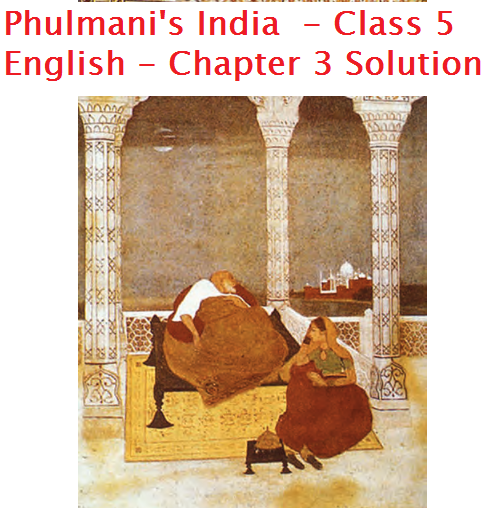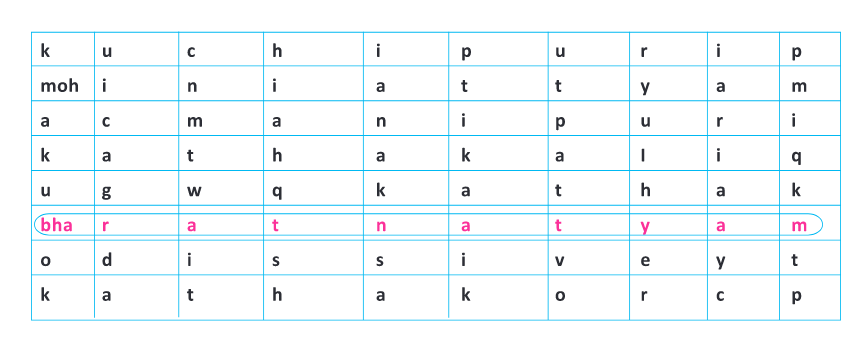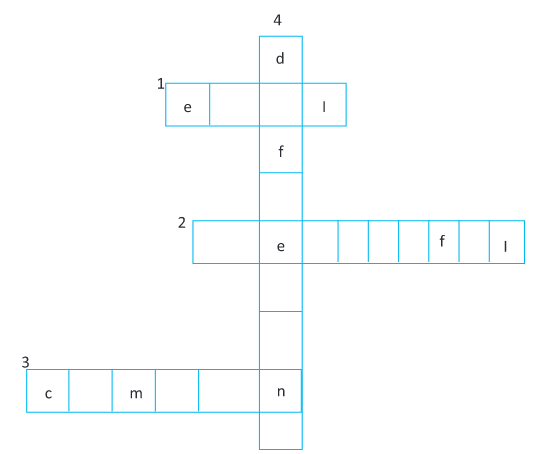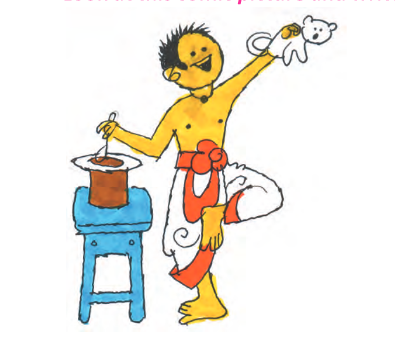WB Board Class 5 English Chapter 3 Phulmani’s India Solution – West Bengal Board of Secondary Education (WBBSE) Class 5 English Text Book Chapter 3 Question Answer from the story Phulmani’s India is provided in this post. Read the Activity Solution of the Phulmani’s India Class 5 from this page and prepare for the upcoming unit test.

Activity 1 Solution
Tick the correct answer:
(1) The rock paintings of Bhimbetka are more than – [a] 1,000 years [b] 20,000 years [c] 12,000 years old.
Answer: [b] 20,000 years
(2) Ajanta is famous for – [a] cave paintings [b] wood paintings [c] canvas paintings.
Answer: [a] cave paintings
(3) Bihu is a popular folk dance of – [a] Punjab [b] Assam [c] West Bengal.
Answer: [b] Assam
Activity 2 Solution
Let’s match the dances with the states:
Answer:
Chhau – West Bengal
Dandiya – Gujrat
Bhangra – Punjab
Activity 3 Solution
Let’s supply the missing information:
1. The primary colours used in the rock paintings at Bhimbetka are ………………………………
Answer: red, white, green or yellow.
2. Most of the Indian dances originated from ………………………………….
Answer: the temples.
3. Sculptures are found in ……………………………….
Answer: Ellora.
4. In the caves of Ajanta we find ………………………………
Answer: fresco.
Activity 4 Solution
Write ‘T’ for true and ‘F’ for false sentences in the given boxes :
1. In India there are many types of classical dances.
Answer: T
2. Kathakali dance originated in northern India.
Answer: F
3. Sitar is a musical instrument.
Answer: T
4. In India there is only one form of classical music.
Answer: F
5. Tansen was a great vocalist.
Answer: T
Activity 5 Solution
Let’s write the answers to these questions:
(1) Which country has a rich heritage of classical dance?
Answer: India has a rich heritage of classical dance.
(2) What is an essential part of Indian classical dance?
Answer: Dramatics is an essential part of Indian classical dance.
(2) What is an essential part of Indian classical dance?
Answer: Emperor Akbar loved to listen to the songs of Tansen.
(4) Which monument in India is among the seven wonders of the world?
Answer: In India Taj Mahal is among the seven wonders of the world.
(5) What is Buland Darvaza?
Answer: Buland Darvaza is the huge gateway at Fatepur Sikri built by Emperor Akbar.
(6) Name the folk theaters of (a) Maharashtra, (b) Bengal, (c) North India.
Answer: The folk theatres of (a) Maharashtra is called tamasha, (b) Bengal is called jatra, (c) North India is called nautanki.
Activity 6 Solution
India is a country of dances. Find the names of these dances in this maze. One is done for you .

Answer:
1. kuchipuri
2. mohiniattyam
3. manipuri
4. kathak
5. bharatnatyam
6. odissi
7. kathak
Activity 7 Solution
Write the opposites of the words given in the clues. You can find the answers in the text:

Clues:
Across:
1) opposite of good Answer: evil
2) opposite of ugly Answer: beautiful
3) opposite of rare Answer: common
Down:
4) opposite of same Answer: different
Activity 8 Solution
Write five sentences about the Tajmahal using the following hints:
Answer:
- Tajmahal is situated at Agra.
- It is beside the river Yamuna.
- This monument is built of marble.
- It is the tomb of Shah Johan and Mumtaz Mahal.
- Tajmahal is one of the seven wonders of the world.
Activity 9 Solution
Let’s replace the bold words with a Personal pronoun:
(1) Jairam is a boy. Jairam studies in class V.
Answer: Jairam is a boy. He studies in class V.
(2) This is a dog. The dog guards our house.
Answer: This is a dog. It guards our house.
(3) Munmun Is a little girl. Munmun goes to school everyday.
Answer: Munmun Is a little girl. She goes to school everyday.
(4) Ranu, James and Imran are friends. Ranu, James and Imran play together.
Answer: Ranu, James and Imran are friends. They play together.
(5) We go to the city by bus. The bus goes fast.
Answer: We go to the city by bus. It goes fast.
(6) I have a mynah. The mynah can talk.
Answer: I have a mynah. It can talk.
(7) My father has a cycle. The cycle is red in colour.
Answer: My father has a cycle. It is red in colour.
Activity 10 Solution
Let’s underline the right answers:
1. Rabi has a little pet dog. Everyone loves the pet dog of [his/him].
Answer: his
2. I read in class V. My school is close to [your/yours].
Answer: yours
3. Rina is my classmate. Her house is near [our/ours].
Answer: ours
4. My father is a painter. There are many paintings of [his/him] in our house.
Answer: his
5. My cousin sings well. The school of [her/hers] has a music teacher.
Answer: hers
Activity 11 Solution
Let’s fill in the blanks with Personal pronouns and Possessive Pronouns:
(1) Uday Shankar was a famous Bengali dancer. _____________ travelled all over the world with his troupe.
Answer: He
(2) Nandalal Bose was a great painter. There are many drawings of _____________ in ‘Sahaj Path’. _____________ was very close to Rabindranath Tagore.
Answer: his, He
(3) Rabindranath Tagore was a great poet. ____________ was also a great painter.
Answer: He
(4) Taj Mahal was built in the memory of Mumtaj Mahal. It is a burial tomb of _____________.
Answer: hers
Activity 12 Solution
Look at this comic picture and write five sentences about it.

Answer:
- This is a picture of a magician.
- He is standing on one leg.
- A hat is kept on a stool.
- He is holding a cat in his left hand.
- He is also holding a magical stick in his right hand.
Activity 13 Solution
Write five sentences about any dance performance that you have seen. Use capital letters at the beginning of sentences. End every sentence with a full stop. you can begin like this:
Answer:
I saw a dance performance at a local theater last night.
The dancers moved gracefully across the stage, their movements fluid and expressive.
The vibrant costumes added a burst of color to the performance, creating a visually stunning spectacle.
The music was a perfect complement to the dance, with its rhythmic beats and melodic melodies.
As the performance came to an end, the audience erupted in applause, appreciating the talent and dedication of the dancers.






